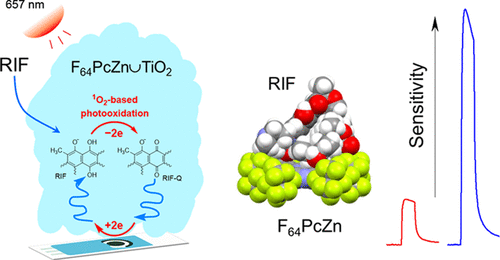Our official English website, www.x-mol.net, welcomes your feedback! (Note: you will need to create a separate account there.)
Enhanced Photoelectrochemical Detection of an Analyte Triggered by Its Concentration by a Singlet Oxygen-Generating Fluoro Photosensitizer
ACS Sensors ( IF 8.9 ) Pub Date : 2020-10-29 , DOI: 10.1021/acssensors.0c01609 Adrian Blidar 1 , Stanislav Trashin , Erik N. Carrión 2 , Sergiu M. Gorun 2 , Cecilia Cristea 1 , Karolien De Wael
ACS Sensors ( IF 8.9 ) Pub Date : 2020-10-29 , DOI: 10.1021/acssensors.0c01609 Adrian Blidar 1 , Stanislav Trashin , Erik N. Carrión 2 , Sergiu M. Gorun 2 , Cecilia Cristea 1 , Karolien De Wael
Affiliation

|
The use of a photocatalyst (photosensitizer) which produces singlet oxygen instead of enzymes for oxidizing analytes creates opportunities for designing cost-efficient and sensitive photoelectrochemical sensors. We report that perfluoroisopropyl-substituted zinc phthalocyanine (F64PcZn) interacts specifically with a complex phenolic compound, the antibiotic rifampicin (RIF), but not with hydroquinone or another complex phenolic compound, the antibiotic doxycycline. The specificity is imparted by the selective preconcentration of RIF in the photocatalytic layer, as revealed by electrochemical and optical measurements, complemented by molecular modeling that confirms the important role of a hydrophobic cavity formed by the iso-perfluoropropyl groups of the photocatalyst. The preconcentration effect favorably enhances the RIF photoelectrochemical detection limit as well as sensitivity to nanomolar (ppb) concentrations, LOD = 7 nM (6 ppb) and 2.8 A·M–1·cm–2, respectively. The selectivity to RIF, retained in the photosensitizer layer, is further enhanced by the selective removal of all unretained phenols via simple washing of the electrodes with pure buffer. The utility of the sensor for analyzing municipal wastewater was demonstrated. This first demonstration of enhanced selectivity and sensitivity due to intrinsic interactions of a molecular photocatalyst (photosensitizer) with an analyte, without use of a biorecognition element, may allow the design of related, robust, simple, and viable sensors.
中文翻译:

产生单重态氧的氟光敏剂的浓度触发的分析物的增强光电化学检测
使用产生单线态氧而不是酶来氧化分析物的光催化剂(光敏剂)为设计经济高效且灵敏的光电化学传感器创造了机会。我们报告说,全氟异丙基取代的锌酞菁锌(F 64 PcZn)与一种复杂的酚类化合物,即利福平抗生素(RIF)发生特异性相互作用,但与对苯二酚或另一种复杂的酚类化合物,即强力霉素不发生相互作用。如电化学和光学测量所揭示,RIF在光催化层中的选择性预浓缩赋予了特异性,并辅之以分子模型,该分子模型证实了异氰酸酯形成的疏水腔的重要作用。-光催化剂的-全氟丙基。预浓缩效应有利地提高了RIF光电化学检测极限以及对纳摩尔(ppb)浓度的灵敏度,LOD分别为7 nM(6 ppb)和2.8 A·M –1 ·cm –2。保留在光敏剂层中的RIF选择性通过使用纯缓冲液对电极进行简单洗涤而选择性去除所有未保留的苯酚来进一步提高。演示了该传感器在分析城市废水中的实用性。由于分子光催化剂(光敏剂)与分析物之间的固有相互作用而提高的选择性和灵敏度的第一个演示,无需使用生物识别元件,就可以设计出相关的,坚固的,简单的和可行的传感器。
更新日期:2020-11-25
中文翻译:

产生单重态氧的氟光敏剂的浓度触发的分析物的增强光电化学检测
使用产生单线态氧而不是酶来氧化分析物的光催化剂(光敏剂)为设计经济高效且灵敏的光电化学传感器创造了机会。我们报告说,全氟异丙基取代的锌酞菁锌(F 64 PcZn)与一种复杂的酚类化合物,即利福平抗生素(RIF)发生特异性相互作用,但与对苯二酚或另一种复杂的酚类化合物,即强力霉素不发生相互作用。如电化学和光学测量所揭示,RIF在光催化层中的选择性预浓缩赋予了特异性,并辅之以分子模型,该分子模型证实了异氰酸酯形成的疏水腔的重要作用。-光催化剂的-全氟丙基。预浓缩效应有利地提高了RIF光电化学检测极限以及对纳摩尔(ppb)浓度的灵敏度,LOD分别为7 nM(6 ppb)和2.8 A·M –1 ·cm –2。保留在光敏剂层中的RIF选择性通过使用纯缓冲液对电极进行简单洗涤而选择性去除所有未保留的苯酚来进一步提高。演示了该传感器在分析城市废水中的实用性。由于分子光催化剂(光敏剂)与分析物之间的固有相互作用而提高的选择性和灵敏度的第一个演示,无需使用生物识别元件,就可以设计出相关的,坚固的,简单的和可行的传感器。



























 京公网安备 11010802027423号
京公网安备 11010802027423号